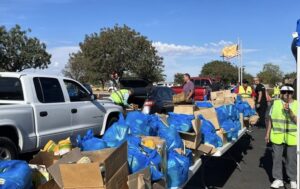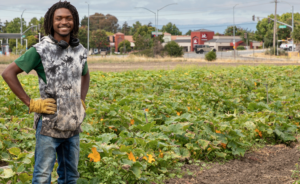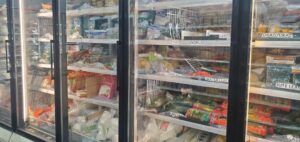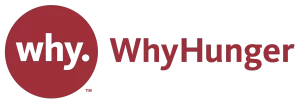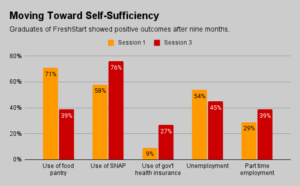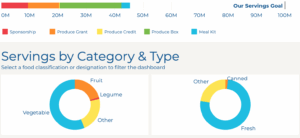When the Food Bank of Western Massachusetts took a hard look at food distribution across its four-county network a few years ago, one thing became strikingly clear: access to emergency food was not equitable, and the reason was race.
The county with the largest concentration of food insecurity, poverty and people of color was also the one receiving the least amount of food, in terms of meals per person in need, said Andrew Morehouse, Executive Director. “It was really obvious that we needed to do something about this,” he said.
As protests calling for greater social justice sweep the nation, food banks across the country are feeling the need to do something. Anti-hunger organizations have long been aware of the ways in which discrimination and racism contribute to poverty, food insecurity and poor health outcomes, and now are eager to express their solidarity with the current movement.
Those expressions are taking many forms, including declarations, goal-settings and internal staffing changes. Food banks that have already set themselves on a course toward equity, inclusion and diversity are perhaps best prepared to meet the expectations of the moment. Food Bank of Western Massachusetts has already achieved greater equity in its food distributions thanks to a three-part effort, begun after a yearlong planning session with its member agencies and pantries.
The food bank knew that the issue bedeviling its pantry network was one of equity. Although more than half of all the food the food bank was distributing was going to the underserved county, it still was not enough to meet the local need. Furthermore, while the county benefited from a large number of feeding programs, the local resources needed to run the programs — such as volunteers, reliable transportation and financial support — were perennially hard to come by. “It was the poorest and largest county, so it had the least resources to invest,” Morehouse explained.
The first part of the plan was to cut in half the shared maintenance fee — typically charged by food banks to defray the overhead costs of making food available — to the pantries in that county. “It was an incentive to make it more affordable so they could acquire more food,” Morehouse said.
The food bank also prioritized bringing on new pantries and meal sites from that county into the network. Finally, it targeted the underserved county when it launched its mobile food pantry program to distribute fresh produce and other perishables directly into communities. Now, about 18 of the food bank’s 26 mobile food pantries operate there.
All the efforts have had an impact. Instead of being at the bottom of the pack, the underserved county is now second to last in terms of providing meals per person in need. (The most successful at meeting need per person are the two most rural counties with the smallest populations.) “We’ve not achieved our utopian goal of equalizing all meals per person in need,” Morehouse said, “but we have shrunk the inequity between them all.”

Other food banks are focused more internally as they strive to fight back against structural racism. Over the past few years, Foodlink of Rochester, NY, has sought to boost its internal minimum wage closer to a living wage, moving it from less than $11 per hour two years ago, to $14 an hour currently, with 90% of the staff employed full-time with benefits, said Julia Tedesco, President and CEO. The food bank is also hiring an employee navigator whose job, starting July 1, will be to connect employees to resources aimed at helping them improve their lives.
Foodlink has also been more intentional in the way it frames its approach to racism, calling it a “public health crisis,” partly in acknowledgment of the food bank’s role as an upholder of public health. The food bank endorsed a statement from a local black agenda group, which argued that racism contributes to health disparities and is increasingly considered a social determinant of health. “It makes absolute sense and feels aligned to what Foodlink knows is true,” Tedesco said of the statement.
Increasing numbers of food banks are engaging in equity, inclusion and diversity training. Northwest Harvest of Seattle strengthened its journey toward racial healing with a two-and-a-half day workshop through the Center for Equity and Inclusion in Portland, Ore., more than two years ago, said Christina Wong, Public Policy and Advocacy Director. Since then, “we’ve gone through an effort to structurally change to be anti-racist,” she said.
The workshop led to ongoing training sessions with leadership and staff aimed at dismantling the dominant culture and raising awareness. The food bank now uses tools, such as an equity filter, which applies four questions to ensure business decisions promote equity and avoid unintended consequences, Wong said.
Universally, food banks believe there is still a lot of work to be done. The equity statement that Alameda County Community Food Bank put out three years ago was bold at the time in its contention that food is a basic human right, said Suzan Bateson, Executive Director. Now the food bank is updating the statement for the new environment, to include things like cultivating leadership that reflects the diversity of its community. “There’s diversity in our directors, but it’s not where it will be a few years from now,” Bateson said.
Food Bank of Western Massachusetts is furthering its commitment to the least prosperous county it serves by moving its warehouse there. While a capital campaign launched at the beginning of the year has been postponed because of Covid-19, the food bank is set to close on a piece of property that would bring it physically closer to the agencies in that county. “Pantries will not have to travel as far, and we’ll be closer on a relational level,” Morehouse said.
Foodlink is committing to being more direct in the language it uses. “We might refer to root causes, but we’ve not done a good job of saying the words ‘poverty’ and ‘racism,’” said Tedesco, noting a reluctance among food banks to bring up issues that could come at the cost of support for food banking. “But words matter a lot,” she said. “We can’t stay true to our mission without addressing these issues and calling them by name.”
Like what you’re reading?

